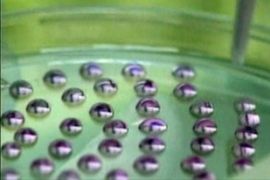Aids study raises breakthrough hope
Researchers find new proteins used by HIV to grow, offering treatment opportunities.

Published On 12 Jan 2008
When scanning all of the genes in the human genome – rather than studying the virus – researchers found 273 protein-coding genes that HIV uses to infect cells and multiply.
Elledge said some of these genes could be used to provide the basis for new drugs to fight Aids.
“It should spur a lot of research [and provide] new and novel ideas about how to thwart this virus,” Elledge said.
“Some drug companies have done these sorts of screens but they didn’t make this information public.”
Elledge said that any drugs that result from the study may be harder, perhaps even impossible, for the virus to develop resistance to.
Proteins identified
HIV has only nine genes which it uses with 15 proteins to attach itself to an individual’s cells and reproduce itself.
If the proteins that the virus needs to live and replicate are known, the virus can more easily be targeted and better treatment provided.
Dr Robert Gallo, a co-discoverer of the Aids virus, told Al Jazeera: “You can’t predict which one of those avenues will pay off better more than another.
“What you can say is, many more ideas are added to possible new forms of therapy for the future.”
The HIV drugs currently available – of which there are about 20 – attempt to work at various stages of the process of the virus attaching to cells and replicating.
However, they cannot completely eliminate the virus, which eventually develops resistance to drugs. Therefore, there is no cure for HIV as yet.
Source: Al Jazeera, News Agencies